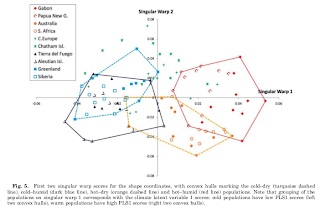 This paper has been sitting on my todo pile for quite a while now. It could very well be described as the most detailed study of human variation of the nose, nasal cavity, and nasopharynx that I've ever seen anywhere.
This paper has been sitting on my todo pile for quite a while now. It could very well be described as the most detailed study of human variation of the nose, nasal cavity, and nasopharynx that I've ever seen anywhere.I don't know that I'm either competent or invested enough to give a full account of the paper, so I will limit myself to the conclusions:
Our study found significant correlations between nasalI had reviewed a similar paper on Neandertal nasal architecture in 2008 which aimed to solve the mystery of why Neandertals had broad noses despite living in a cold and dry environment. It might be a good idea to see how Neandertals would fit in the model presented by the authors in this paper.
cavity morphology as reflected by our dataset and both
temperature and vapor pressure variables. The bony
nasal cavity appears mostly associated with tempera-
ture, and the nasopharynx with humidity. Most impor-
tantly, nasal cavities from cold–dry climates are
relatively higher and narrower compared with those of
hot–humid climates, agreeing with previous findings on
the nasal aperture. The shape changes found are func-
tionally consistent with an increase in contact between
air and mucosal tissue in cold–dry climates by increase
of turbulence during inspiration and increase in surface-
to-volume ratio in the upper nasal cavity. However, the
observed shape differences are relatively modest and
show population overlap, which might indicate a compro-
mise morphology of the nasal cavity and/or the absence
of extreme adaptations that would reduce the versatility
of humans as generalists and a mobile species. Future
study including internal measurements and larger/more
diverse population samples will further refine our find-
ings and improve our understanding of the role of the
nasal cavity in modern human climate adaptation.
American Journal of Physical Anthropology DOI: 10.1002/ajpa.21523
Climate-related variation of the human nasal cavity
Marlijn L. Noback
Abstract
The nasal cavity is essential for humidifying and warming the air before it reaches the sensitive lungs. Because humans inhabit environments that can be seen as extreme from the perspective of respiratory function, nasal cavity shape is expected to show climatic adaptation. This study examines the relationship between modern human variation in the morphology of the nasal cavity and the climatic factors of temperature and vapor pressure, and tests the hypothesis that within increasingly demanding environments (colder and drier), nasal cavities will show features that enhance turbulence and air-wall contact to improve conditioning of the air. We use three-dimensional geometric morphometrics methods and multivariate statistics to model and analyze the shape of the bony nasal cavity of 10 modern human population samples from five climatic groups. We report significant correlations between nasal cavity shape and climatic variables of both temperature and humidity. Variation in nasal cavity shape is correlated with a cline from cold–dry climates to hot–humid climates, with a separate temperature and vapor pressure effect. The bony nasal cavity appears mostly associated with temperature, and the nasopharynx with humidity. The observed climate-related shape changes are functionally consistent with an increase in contact between air and mucosal tissue in cold–dry climates through greater turbulence during inspiration and a higher surface-to-volume ratio in the upper nasal cavity.
Link

4 comments:
Cold-humid and hot-dry overlap.
The only thing that the PC graph indicates is width (SW1) and prominence (SW2), what may or not have any adaptive value but are obvious to anyone without having to pretend being statistically insignificant.
"nasal cavities from cold–dry climates are
relatively higher and narrower compared with those of
hot–humid climates"
Why do inuits (eskimos) not appear to follow this template or do they?
Some years ago a swedish scientist made a research on two(?) different ancient populations in Sweden and compared them with modern saamis, that showed saamis (and one of the ancient populations too) to be coldresistent, their nasal cavities was narrower and they had bones that had adapted (during many thousands of years) to cold climate( shorter underlegs), and their teeth showed what they had been eating, marine animals.
People were compared to the arctic fox (fjällräven) to have been in their living areas for very long time. His name is Torbjörn Ahlström, 1997.
It needs a very long time to adapt.
Post a Comment